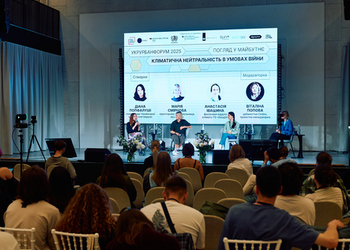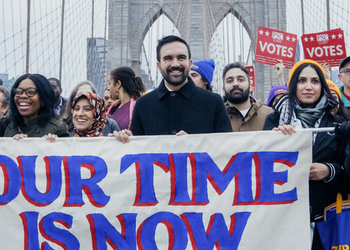The Study on mechanisms of citizens’ engagement in the decision-making in Kyiv has been carried out by the CEDOS Think Tank as a part of the implementation of the Council of Europe project «Promoting Citizen Participation in Democratic Decision Making in Ukraine». This is a brief summary of the study results.
The brief summary of the study results in Ukrainian is available by the following link.
The study results of interactions between local authorities and civil society in Lviv are available by the following link. The study results of interactions between local authorities and civil society in Kharkiv are available by the following link.
An important element of citizen participation in the social and political life and in decision making process in the city is the cooperation between civil government bodies and civil society institutions (NGOs, initiatives and activists). Civil society organizations, on the one hand, represent the interests of their members, wide social interests and the interests of various social groups. On the other hand, they themselves are a mechanism of civil participations for the residents of the city. Due to this fact, cooperation between government bodies and civil society organizations is a strategically important task for building democracy, good governance, trust and consensus in the community.
Conclusions
The analysis of legislation and regulations determined 20 formal mechanisms of citizen participation that exist in Kyiv: local referendum, general assembly of residents according to their place of residence, population self-organization bodies (OSN), public hearings, public hearings about urban planning documents, local initiatives, public expertise, consultations with the public, public councils, citizen appeals, electronic petitions, the 1551 contact center, personal meetings, public receptions, requests for public information, consultative and advisory bodies, participatory budget, public control over landscaping and beautification, the competition of local government projects and development programs, public participation in competition commissions and committees. The availability of this range of different mechanisms provides a variety of choices of the most convenient mechanisms of participation, including online participation. Some of these mechanisms have defined procedures and sample documents, which makes their use easier. The procedures for most of the mechanisms of public participation provide that government agencies have to consider citizens’ suggestions and give motivated answers to them, and include requirements that the process of consideration must be covered at official websites and in the communal media.
However, the available range of mechanisms also has some faults. In particular, the use of voting as a decision-making tool in some of the mechanisms makes them vulnerable to manipulation. In addition, the majority of the mechanisms do not provide any opportunity for taking into account the minority opinion, looking for consensus, trust and understanding, and engaging all the stakeholders. The use of some of the instruments, especially the ones that involve the collection of signatures or votes, requires major resources, which is a barrier for vulnerable groups. It is also important that the majority of the mechanisms of public participation are not coordinated. For example, not all mechanisms of online participation provide an alternative possibility to join offline (and the other way around, the majority of offline mechanisms do not allow for online participation). The procedures for some of the mechanisms are rather complicated, and there are no simple and comprehensible explanations available on how to use them. There is also no unified portal (shared by different government agencies) which would bring together the information about all the available mechanisms of public participation.
The analysis of the decision-making strategies of city government representatives has showed that decisions about the priority areas of development are based on the existing strategic city development documents; on the analysis of citizens’ appeals, petitions and complaints; and on the personal experience, knowledge and beliefs of the local government leadership (the head of the Kyiv City State Administration, his deputies, and departments heads). We discovered that the main driver in the process of making decisions about priorities in city policies is the personal vision and will of the city’s managers.
The involvement of residents and representatives of the civil society is not systematic. Decisions about involving them are based on regulations and the will of the city administration. Representatives of the city government admit that the communication about cooperation with the civil society is episodic. They realize that the city needs a strategy that should be developed and implemented by separate new specialists.
According to the assessments by representatives of the city government and the civil society, the most effective methods of citizen engagement are the online mechanisms that involve a mandatory feedback system: the 1551 contact center, the participatory budget, and the electronic petitions. The most widespread mechanisms are the ones that perform the function of collecting feedback from residents after the fact, rather than the ones which work preventively, before a decision is made. The most influence over the city government’s decision making is exercised by those activists who have more social capital; who are able to meet officials in person; and who are more active and persistent.
The practices of involving activists and residents in the management of the city vary between different KCSA departments. Some departments organize regular roundtables, working groups, commissions involving representatives of the civil society and active citizens. These forms of engagement are advisory. A few departments have financial support programs for NGOs.
The study revealed the main barriers and difficulties faced by representatives of the local government, by residents and representatives of the civil society in the processes of communication, consultation and the actual decision making. The central problem is the mutual lack of trust and mutual stereotypes based on the poor knowledge of the system of city government and citizen engagement, prejudice, previous negative experiences of collaboration, the unsystematic nature of interactions, the selective approach of city government bodies to the civil society. The main barriers to engagement also include mutual lack of familiarity and the lack of understanding whom to address in order to establish communication; as well as the mismatch between the mutual expectations of residents and the city government: decisions are made slowly and communicated poorly. The civil society blames the local government for indifference and inefficient work. In the process of interaction, both sides have to go through traumatic conflict situations. All of this kills the local government’s will to interact with NGOs in the future, and they develop a too distant stance towards ordinary residents, considering traditional appeals and complaints the most effective mechanism of their engagement. The workload of their core job responsibilities prevents the employees of the local government from dedicating enough time to implementing the engagement mechanisms. Another important barrier is the lack of practices of early involvement of residents in city management.
Representatives of the civil society complain about the lack of transparency in the system of government organization. They look for possibilities to resolve their questions mostly through personal contacts, because they have tried to use a number of the available public participation mechanisms and were disappointed in their effectiveness. There are many mechanisms, but in all of them the public opinion is purely advisory. In the experience of civil society representatives, decisions about whether or not to take into account the public opinion depend on the circumstances and the high profile of the cause. It means that the engagement mechanisms are weak and need to be reformed, articulating the clear mechanisms and criteria of the methods and conditions under which the public’s suggestions can or must be taken into account in the local government’s decision making.
Despite the fact that government representatives and civil society representatives have somewhat different positions and ideas about the interaction between them, effective training can actually overcome this barrier. These training programs should revolve around the topics shared by both government bodies and the civil society, such as communication, conflict communication, moderation, facilitation and mediation, basic PR and SMM (Facebook as the main channel of communication), successful public participation practices from other countries.
Practical training formats, such as workshops, project seminars or educational role-playing games should be used, because the potential participants of the training emphasized the importance of an interactive process, of its practical direction. The results of the training should also be specific and practical. For example, a resolution of a modelled conflict situation, a draft decision for a relevant city problem, a communication strategy for a certain department, the model and the regulations for the future communications office that would be responsible for the interaction between government bodies and the civil society.
Special attention should be paid to the time and schedule of the training. It must be organized in such a way that it would be convenient for potential participants to participate. The schedule has to be convenient for both public officials in different positions and for civil society representatives. For this purpose, some training modules can be organized separately on weekends and on workdays (during and after the working hours), so that people could have more opportunities to participate.
In addition to gaining knowledge and skills, an important result of such training would be increased mutual trust, because during the classes government representatives and civil society representatives will have a chance to learn more about each other, to overcome mutual stereotypes, and to realize that they have shared goals which they can work to achieve together.
Recommendations
- To introduce on the regulatory level the mechanisms of early involvement of residents in decision making (at the stages of strategizing, defining priorities, formulating technical tasks, developing projects). Mechanisms of such involvement are, first of all, informing, design workshops, pre-design studies, public discussion of concepts.
- To diversify the forms of participation in each of the mechanisms of civil participation, providing the users with an opportunity to choose which form is more convenient to them: a public event, a personal appointment, a physical letter, a phone call or electronic participation. This will allow to remove the obstacles to the involvement of certain social groups, often the vulnerable groups, in certain mechanisms of civil participation which currently do not provide different forms of participation.
- To organize educational events, providing the city residents, civil society organizations and activists with the necessary information on the topics which will be considered using a certain mechanism of civil participation. This will allow to remove the obstacle of the level of expertise required to participate, and will make civil participation more informed and effective.
- To improve the procedure for organization of those mechanisms of participation for which it is not sufficiently detailed. Where possible, to standardize similar procedures present in different mechanisms of civil participation, in order to make their use simpler. Extrapolate the best practices included in the procedures for some mechanisms of civil participation to other mechanisms.
- Where possible, if it is necessary to make decisions during discussions, introduce consensus-seeking practices, rather than voting. Voting does not provide the opportunity for dialogue and raise the level of dissatisfaction with the result. Voting procedure is vulnerable to bribery and manipulation, does not allow to take into account the interests of the minority, does not provide opportunities to clarify problematic questions, to seek consensus, trust and understanding, and to involve all stakeholders.
- To create a convenient and clear infographics about the procedures for implementing all the mechanisms of civil participation, which could be used by residents of Kyiv, and to develop the single platform where they could find all the information about all the mechanisms of civil participation in a convenient and accessible form, as well as directly participate in these mechanisms.
- To develop methodological recommendations for civil servants about using all the mechanisms of civil participation. Accordingly, include the use of these mechanisms in the job responsibilities of civil servants and develop a system of incentives to use them. Develop educational and motivational programs for residents of the city, civil activists and civil society organizations, based on the experience of public budgeting, which stimulated the intensification of cooperation between activists, the creation of NGOs, and the involvement of residents.
- In addition to involving civil society organizations, activists and experts, more attention should be paid to involving «regular» residents, who are currently not active in community life.
- In the development of any legislation, methodological recommendations or other documents that regulate civil participation, and in the development and use of the mechanisms of civil participation themselves, attention must be paid to the gender aspect and the interests of vulnerable social groups. For example, public events should be scheduled for non-working hours; events should be held in venues which are accessible for people with disabilities; conditions should be created for parents with children to participate in public discussions.
- Decentralize decision making about when and how to use the mechanisms of civil participation, from higher-level officials to lower levels.
- To introduce practices of delegating certain functions or services from government agencies to NGOs.
- To establish cooperation, formal and informal communication and exchange of experience of public particitation between representatives of different departments of the city administration.
- To introduce the system of non-formal education for the city residents on administration system, division of responsibilities and subordination, mechanisms of involvement in the decision making process. Education should be informal. Information should be delivered in an accessible and understandable form. Possible mechanisms of engagement to the education process: educational meetings in schools with administration representatives and civil activists; public city festivals; social advertisements; days of open doors in city authorities; webinars and online courses. A separate area of such education should be the skills of communication, constructive dialogue and constructive criticism.
- To create conditions for the exchange of experience in implementing urban projects, involving citizens between civil society and city authorities. The process of cooperation should be conducted in informal form.
- To inform citizens about successful practices of joint implementation of projects by civil society and city authorities involving the inhabitants. Informing process should be conducted in an interesting and informal way.
- The premises where the city authorities are located must demonstrate spatial openness and democracy. Spaces must be equipped, taking into account the needs of vulnerable categories of inhabitants.
- To create conditions for the involvement of non-governmental organizations in competitive programs and projects aimed at implementation of urban development projects. Such programs will give opportunity to to strengthen cooperation between public organizations and city government bodies.
- To establish offices in the city districts that will be responsible for the development and implementation of community development strategies, district spatial planning, the engagement of residents in the decision-making process and interaction with civil society representatives.





